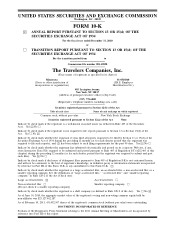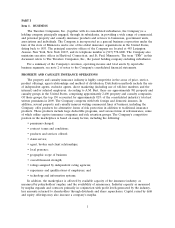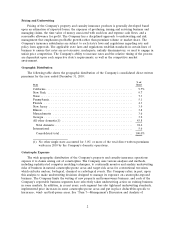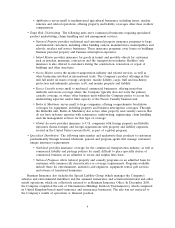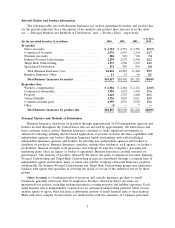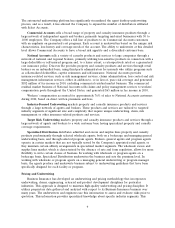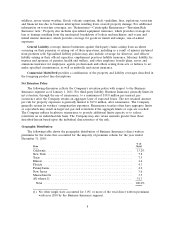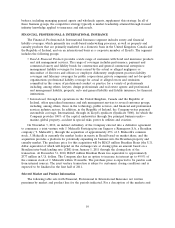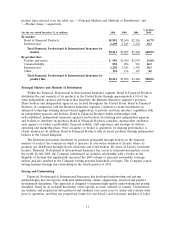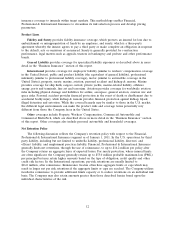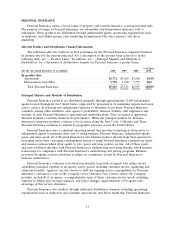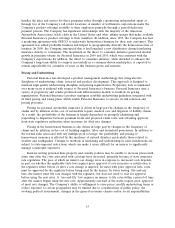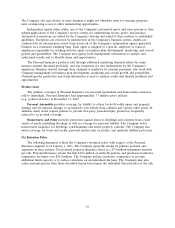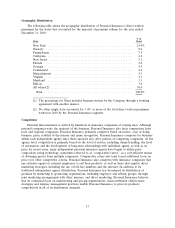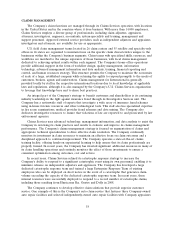Travelers 2010 Annual Report Download - page 21
Download and view the complete annual report
Please find page 21 of the 2010 Travelers annual report below. You can navigate through the pages in the report by either clicking on the pages listed below, or by using the keyword search tool below to find specific information within the annual report.Competition
The insurance industry is represented in the commercial marketplace by many insurance
companies of varying size as well as other entities offering risk alternatives such as self-insured
retentions or captive programs. Market competition works within the insurance regulatory framework to
set the price charged for insurance products and the levels of coverage and service provided. A
company’s success in the competitive commercial insurance landscape is largely measured by its ability
to provide insurance and services, including claims handling and risk control services, at a price and on
terms that are reasonable and acceptable to the customer, as well as its ability to retain existing
customers and to attract new customers.
Select Accounts business is typically written through independent agents and, to a lesser extent,
regional brokers and direct writers. Both national and regional property and casualty insurance
companies compete in the Select Accounts market which generally comprises lower-hazard, ‘‘Main
Street’’ business customers. Risks are underwritten and priced using standard industry practices and a
combination of proprietary and standard industry product offerings. Competition in this market is
primarily based on product offerings, service levels, ease of doing business and price. Select Accounts
has established a strong marketing relationship with its distribution network and has provided this
network with defined underwriting policies, a broad array of products, competitive prices and a highly
efficient, automated platform that significantly reduces the time period between quoting a price on a
policy and issuing that policy. In addition, the Company has established centralized service centers to
help agents perform many service functions, in return for a fee.
In recent years, many independent personal insurance agents have begun to utilize price
comparison rating technology, sometimes referred to as ‘‘comparative raters,’’ as a cost-efficient means
of obtaining quotes from multiple companies. Comparative raters also tend to put additional focus on
price over other competitive criteria. The Company believes that there is the potential for similar
technology to be used to access comparative rates for small commercial business.
Commercial Accounts business has historically been principally written through independent agents
and brokers. Competitors in this market are primarily national property and casualty insurance
companies that write most classes of business using traditional products and pricing, and regional
insurance companies. Companies compete based on product offerings, service levels, price and claim
and loss prevention services. Efficiency through automation and rapid response time to customer needs
is one key to success in this market.
In the National Accounts market, competition is based on price, product offerings, claim and loss
prevention services, managed care cost containment, risk management information systems and
collateral requirements. National Accounts competes with national property and casualty insurance
companies. In addition, Discover Re competes with those same insurance companies, as well as with
other underwriters of property and casualty insurance in the alternative risk transfer market, such as
risk retention groups, self-insurance plans, captives managed by others, and a variety of other
risk-financing vehicles and mechanisms. The residual market group competes for state contracts to
provide claims and policy management services. National Accounts services approximately 31% of the
total workers’ compensation assigned risk market, making the Company one of the largest servicing
carriers in the industry.
There are several other business groups in Business Insurance that compete in focused target
markets. Each of these markets is different and requires unique combinations of industry knowledge,
customized coverage, specialized risk control and loss handling services, and partnerships with agents
and brokers that also focus on these markets. Some of these business groups compete with national
carriers with similarly dedicated underwriting and marketing groups, whereas others compete with
smaller regional companies. Each of these business groups has regional structures that allow them to
deliver personalized service and local knowledge to their customer base. Specialized agents and
9


